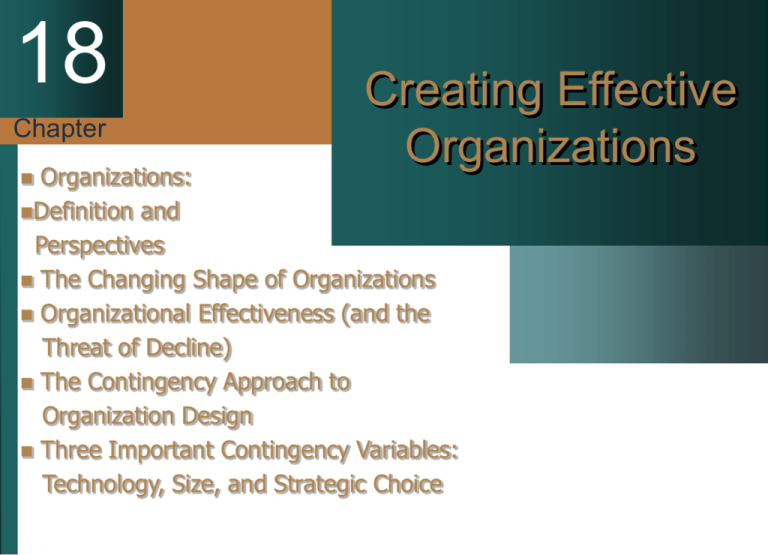
18
Chapter
Creating Effective
Organizations
Organizations:
Definition and
Perspectives
The Changing Shape of Organizations
Organizational Effectiveness (and the
Threat of Decline)
The Contingency Approach to
Organization Design
Three Important Contingency Variables:
Technology, Size, and Strategic Choice
18-2
Figure 18-1
Characteristics Common to All Organizations
Hierarchy of
authority
Division of
labor
McGraw-Hill
Coordination
of effort
Common
goal
© 2004 The McGraw-Hill Companies, Inc. All rights reserved.
18-3
Figure 18-2
Organization Charts
Example of Hospital's Organization Chart
Board of Directors
Type title here
Strategic Planning
Officer
Chief Executive
Officer
Legal Counsel
President
Cost-Containment
Staff
Executive
Administrative
Director
Director of
Human
Resources
Director of
Admissions
Director of
Patient and
Public
Relations
McGraw-Hill
Director of
Accounting
Executive
Medical
Director
Director of
Nutrition
and Food
Services
Director of
X-Ray and
Laboratory
Services
Director of
Surgery
Director of
Pharmacy
Chief
Physician
Director of
Outpatient
Services
© 2004 The McGraw-Hill Companies, Inc. All rights reserved.
18-4
Closed Vs. Open Systems
Closed
System a
relatively self-sufficient
entity
McGraw-Hill
Open
System organism
that must constantly
interact with its
environment to survive
© 2004 The McGraw-Hill Companies, Inc. All rights reserved.
18-5
Figure 18-3
The Organization as an Open System
Goals and Values
Subsystem
Technical
Subsystem
Inputs
Material
Money
Managerial
Subsystem
Human effort
Information
Structural
Subsystem
Psychological
Subsystem
Outputs
Products
Services
Human
satisfaction
Organizational
survival and
growth
Social
benefit
Feedback
McGraw-Hill
© 2004 The McGraw-Hill Companies, Inc. All rights reserved.
18-6
Learning Organization
Learning
Organization
proactively creates,
acquires, and transfers
knowledge throughout
the organization
McGraw-Hill
© 2004 The McGraw-Hill Companies, Inc. All rights reserved.
Profiles of the New-Style and
Old-Style Organizations
New
Old
Dynamic, learning
Stable
Information rich
Information is scarce
Global
Local
Small and large
Large
Product/customer oriented
Functional
Skill oriented
Job oriented
Team oriented
Individual oriented
Involvement oriented
Command/control oriented
Lateral/networked
Hierarchical
Customer oriented
Job requirements oriented
McGraw-Hill
18-7
Table 18-1
© 2004 The McGraw-Hill Companies, Inc. All rights reserved.
18-11
Figure 18-5
Ways to Organizational Effectiveness
Goal
Accomplishment
Resource
Acquisition
Internal
Processes
Strategic
Constituencies
Satisfaction
McGraw-Hill
© 2004 The McGraw-Hill Companies, Inc. All rights reserved.
18-12
Figure 18-5
Organizational Effectiveness Criterion
Goal
Accomplishment the organization achieves its
goals—most widely used effectiveness criterion
Resource
Acquisition the organization acquires the
resources it needs
Internal
Processes the organization functions
smoothly with a minimum of internal strain
Strategic
Constituencies Satisfaction the
demands and expectations of key interest groups are at
least minimally satisfied
McGraw-Hill
© 2004 The McGraw-Hill Companies, Inc. All rights reserved.
18-13
Figure 18-6
Identifying Strategic Constituencies
Financial community
Stockholders
Press
Competitors
U.S., Foreign
OPEC
State and Local
Government
Federal
Government
Customers
Major Auto
Manufacturer
Auto Dealers
Consumer activists
Congress
Suppliers
Executive Branch
Government regulators
Environmentalists
McGraw-Hill
Employees
Unions
© 2004 The McGraw-Hill Companies, Inc. All rights reserved.
18-16
Figure 18-7
Assessing Environmental Uncertainty
Low
Moderate
High
1)
How strong are social,
political, and economic
pressures on the
organization?
Minimal
Moderate
Intense
2)
How frequent are
technological
breakthroughs in the
industry?
Infrequent
Occasional
Frequent
3)
How reliable are
resources and supplies?
Reliable
Occasional,
predictable
shortages
Unreliable
4)
How stable is the
demand for the
organization’s product
or service?
Highly stable
Moderately
stable
Unstable
McGraw-Hill
© 2004 The McGraw-Hill Companies, Inc. All rights reserved.
Differentiation and Integration are
Opposing Structural Forces
18-17
Figure 18-8
Type title here
Type name here
Type title here
thuis
adfjhk
tathkh
adfaf
tat
stat
Type name here
Type title here
at
at
at
ast
at
st
Differentiation
Fragments the organization
through specialization of
labor
Integration
Pulls
the organization together through
the coordination of specialties
McGraw-Hill
© 2004 The McGraw-Hill Companies, Inc. All rights reserved.
Characteristics of Mechanistic and
Organic Organizations
Characteristic
Mechanistic
Organizations
Organic
Organizations
1)
Task definition and
knowledge required
Narrow; technical
Broad; general
2)
Linkage between
individual’s contribution
and organization’s
purpose
Vague or indirect
Clear or direct
3)
Task flexibility
Rigid; routine
Flexible; varied
4)
Specification of
techniques, obligations,
and rights
Specific
General
McGraw-Hill
18-18
Table 18-2
© 2004 The McGraw-Hill Companies, Inc. All rights reserved.
Characteristics of Mechanistic and
Organic Organizations
18-19
Table 18-2 cont.
Characteristic
Mechanistic
Organizations
Organic
Organizations
5)
Degree of hierarchal
control
High
Low
6)
Primary communication
pattern
Top-down
Lateral
7)
Primary decisionmaking style
Authoritarian
Democratic;
participative
8)
Emphasis on obedience
and loyalty
High
Low
McGraw-Hill
© 2004 The McGraw-Hill Companies, Inc. All rights reserved.
18-20
The Effect of Technology on Structure
McGraw-Hill
The more the technology
requires interdependence
between individuals
and/or groups, the
greater the need for
coordination
“As technology moves
from routine to
nonroutine, subunits
adopt less formalized and
centralized structures”
© 2004 The McGraw-Hill Companies, Inc. All rights reserved.
Organizational Size and Performance:
Research Insights
18-21
Larger organizations tended
to be more productive
There were “no positive
relationships between
organizational size and
efficiency, suggesting the
absence of net economy of
scale effects”
There were zero to slightly
negative relationships
between subunit size and
productivity and efficiency
According to a more recent
study, turnover was not
related to organizational size
McGraw-Hill
© 2004 The McGraw-Hill Companies, Inc. All rights reserved.
18-22
Relationship Between Strategic Choice and
Organizational Structure
Figure 18-9
Organizational
objectives
Environmental
constraints
Strategic
decisions made
by dominant
coalition
Organizational
Strategies
Organizational
structure
Organizational
effectiveness
Target markets
Capital
sources/uses
Decision
maker’s
personal beliefs,
attitudes,
values, and
ethics
Human
resources
Technology
Total quality
management
Corrective action
McGraw-Hill
© 2004 The McGraw-Hill Companies, Inc. All rights reserved.






